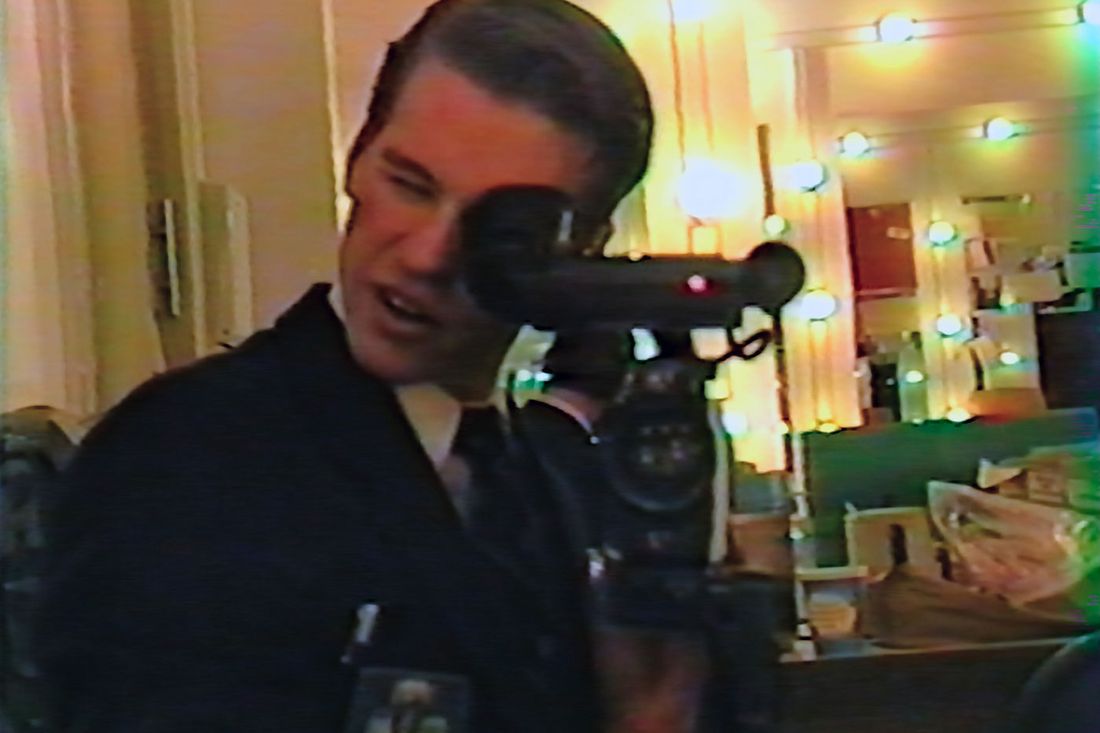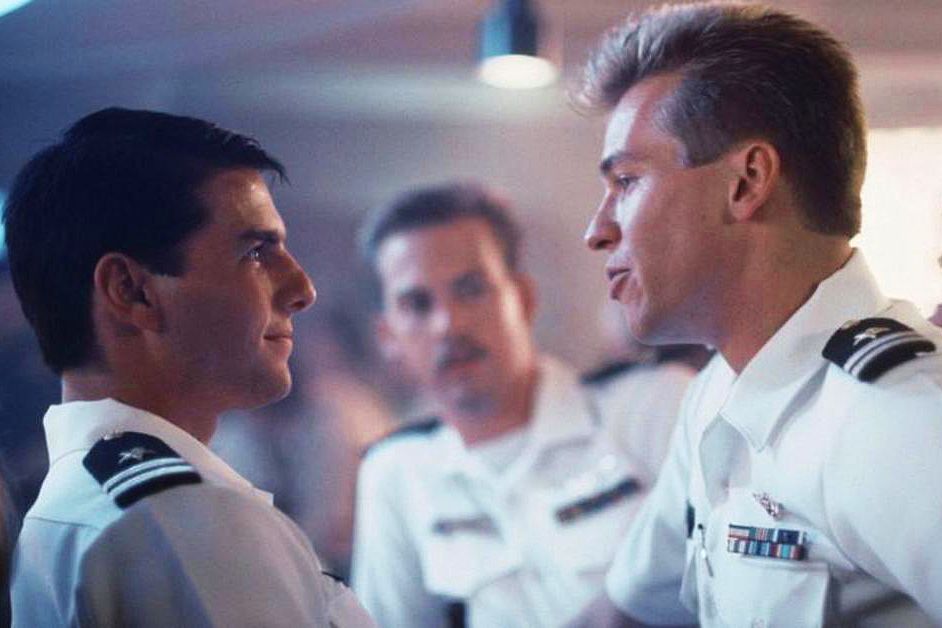
The interview was initially published on July 7, 2021, in line with the Cannes Film Festival debut of the documentary “Val”, which features footage that Val Kilmer himself captured throughout his life and career. Sadly, Kilmer passed away on April 1, 2025 at the age of 65.
In his documentary titled “Val“, it’s revealed that Val Kilmer, who has been acting in other people’s films for 40 years, actually started filming himself much earlier. As a child on his father’s ranch in California, he and his late brother Wesley would make homemade 16-mm. remakes and spoofs of their favorite movies. Throughout his career, Kilmer captured not only the high points like playing iconic characters such as Doc Holliday, Batman, Jim Morrison, and Iceman, but also his personal struggles, including the ups and downs of his marriage to Joanne Whalley, his battle with throat cancer in 2017, and his relentless pursuit to create a theater show based on Mark Twain’s life.
Kilmer collaborated with directors Leo Scott and Ting Poo, along with editors, to sift through the extensive video collection Kilmer had accumulated over time. The result is an extraordinary and captivating portrayal: a glimpse into the actor’s well-known, at times turbulent career and personal life, primarily from his perspective. Val, which debuted at Cannes Film Festival, is a genuinely unexpected and peculiar film that swiftly moves between intense emotional highs and lows. We witness grainy, eccentric footage of Val and Wesley as carefree children before learning (through Kilmer’s son Jack’s voice-over) that the actor’s brother tragically drowned in their family’s hot tub following an epileptic seizure. We hear Kilmer briefly addressing rumors about his challenging demeanor on film sets while watching footage of him on those very sets. (A notable instance: his effort to converse with a melancholic-looking Marlon Brando — his lifelong idol — on the set of the infamous Island of Dr. Moreau.) We see him navigating his way through Juilliard as a raw-talent 17-year-old and discovering, in an early Off Broadway play where he was listed lower in the cast, that he yearned to be taken seriously. This is followed by parts in less serious films like Top Gun and the spy spoof Top Secret!, and eventually Batman, which demanded a suit that impeded him from expressing himself emotionally, or even breathing effectively. He attends fan conventions and screenings for his most popular films, waving and signing autographs, while in voice-over he admits to anticipating feelings of embarrassment at such events, promoting a past version of himself.
In simpler terms, the directness and honesty of Kilmer’s account of his life in this documentary is both charmingly innocent and somewhat mysterious, as there aren’t many other perspectives presented about the events. Essentially, we are hearing Kilmer’s version of everything, and while some details may be missing, it’s important to remember that the film wasn’t made to be objective. Instead, it aims to convey Kilmer’s feelings, as he was a man who lived his life expressing something intensely to an audience. Towards the end of his life, he even needed to press a button on his throat to speak.
Since uninterrupted conversations are challenging through email, our discussion about the film took place over several days via emails. Although Kilmer shared some insights with me, it’s evident that he prefers letting his films do most of the talking. Before the premiere of his movie, we exchanged questions and answers back and forth for a few days. While he gave me a glimpse into his world, it’s clear that he is more comfortable keeping his personal life private.

As a movie enthusiast, I’ve always been capturing moments since I was one of the budding filmmakers in our humble Chatsworth neighborhood back in Los Angeles. I was among the earliest to own a camera among my peers, and that’s how the storytelling began for me.
As I sifted through the footage, I couldn’t help but feel that there was a compelling narrative lurking beneath the surface – one that delved deeper into the life of an artist like myself. So, yes, I’ve always envisioned this collection of moments as the foundation for a documentary about my own journey.
As a child, I wasn’t certain that I would become a renowned actor worthy of documentaries, but I had a strong sense of self-awareness and knew that acting was my path.
How did everything come about regarding this project? I teamed up with Leo Scott and Ting, and here’s a brief overview of our collaboration. Around a decade ago, Leo arrived in America and became instrumental in helping me portray Mark Twain as an American narrator. We shared similar creative visions, which made our partnership truly special. Over the years, we spent countless hours together, sifting through approximately 200 boxes of 8-mm., Super 8, 16-mm. film and video, even working late into the night. My producing partners encouraged me to share my own story, and Leo introduced Ting to the project, who then created a captivating preview. In many ways, it felt like we’d been working on it for years. Ting has a unique ability to blend past and present in smooth transitions, while Leo’s artistic touch, Ting’s award-winning skills, and my determination seem to form a remarkable trio, much like a perfectly cut diamond.
In your movie, what was the purpose you aimed to achieve? A press release described you as “one of Hollywood’s most enigmatic or misinterpreted actors,” and I’m intrigued if you relate to this label – whether you find yourself to be complex or misunderstood by others.
In a more introspective perspective, life is a spiritual voyage for me, and my goal is to stay mindful and present. This has led me through various extremes, some filled with light and others with darkness. I’ve never been shy about sharing my opinions regarding the stories we tell, which has often resulted in creative friction. However, it’s not always about conflict. I’ve had many rewarding collaborations with filmmakers as well.
The document mentions that my intense approach to acting might be seen as challenging by some people.
You’ve had your struggles with the complexities of mainstream stardom in the entertainment industry, particularly when it conflicts with your ambition to be recognized as a more serious actor. Originally trained for stage roles, you still identify with that label, but film is where your passion lies. The industry operates in a specific manner; sometimes I’ve succeeded, other times not. As I worked on my Twain [show] for Broadway, my focus was always on the potential movie adaptation. I’ve evolved, adapted, and remained consistent. My enthusiasm for a remarkable performance remains as strong today as it was the day I discovered Marlon Brando.
In the early stages of the movie, I shared a story about being third on the call sheet during an Off Broadway production alongside Sean Penn and Kevin Bacon. I explained that not all characters are equally impactful, and it was evident to me that my journey was one of pursuing roles that would metamorphose me. As for my career, the parts of Hamlet, Doc Holliday, Mark Twain, and Jim Morrison were transformative in this sense.
Are you saying that you immersed yourself completely in the persona of Jim Morrison for an entire year? Is it essential for you to dedicate such intensity when assuming a character, or do you find this method effective for every role you undertake?
Do you regret taking any roles?
No.
Have you ever pondered over the role of Batman, which you previously described as more limiting than empowering? Has your assessment of your acting in that film evolved or remained consistent throughout the years?

Initially, I had reservations about Top Gun due to its perceived silliness and war-like nature. However, reuniting with the team for the sequel was a compelling draw. I can’t reveal much about the movie’s storyline, but let’s just say it was an opportunity I couldn’t resist.
In your career, there’s a significant span of about 20 years where I immersed myself entirely in the tales of Mark Twain and Mary Baker Eddy. My one-man show titled “Citizen Twain” was more like a preliminary run for the movie project I’ve been diligently working on. Currently, there are several related ventures that I am actively engaged with. So, when I portrayed Val in the film “Song to Song”, it was a way of skirting around this substantial part of my career.
What’s the scheduled release date for your animated production, “Mark Twain’s Dreams of the Resurrection”? As of now, no date has been set.
Among all the clips collected while working on Val, what stood out as the most unexpected or challenging to watch was my brother Wesley’s footage. He was incredibly gifted. Tragically, our mother passed away during the production of [Val], and there are some moving scenes from that period. Ting and Leo managed to breathe life into her through their skillful editing. Any clip featuring Marlon also touched me deeply; he held a special place in my heart.
In this documentary, I didn’t make a conscious choice to be open and truthful; rather, it was an organic expression of who I am. There are some very personal moments in the film, such as my grief over my mother’s passing and discussing custody matters for my children during divorce proceedings, but these were not decisions I made – they just happened to be a part of my authentic self.
Is there anything from your life you chose to leave out in this document because it didn’t seem significant or engaging enough?
If given the chance to travel back in time, I’d advise myself to slow down a bit and spend more time doing nothing. Also, I would encourage myself to pray more often.
Read More
- 50 Ankle Break & Score Sound ID Codes for Basketball Zero
- Who Is Harley Wallace? The Heartbreaking Truth Behind Bring Her Back’s Dedication
- 50 Goal Sound ID Codes for Blue Lock Rivals
- Mirren Star Legends Tier List [Global Release] (May 2025)
- Pacers vs. Thunder Game 7 Results According to NBA 2K25
- League of Legends MSI 2025: Full schedule, qualified teams & more
- Pacers vs. Thunder Game 1 Results According to NBA 2K25
- Jeremy Allen White Could Break 6-Year Oscars Streak With Bruce Springsteen Role
- 100 Most-Watched TV Series of 2024-25 Across Streaming, Broadcast and Cable: ‘Squid Game’ Leads This Season’s Rankers
- KPop Demon Hunters: Real Ages Revealed?!
2025-04-02 19:58